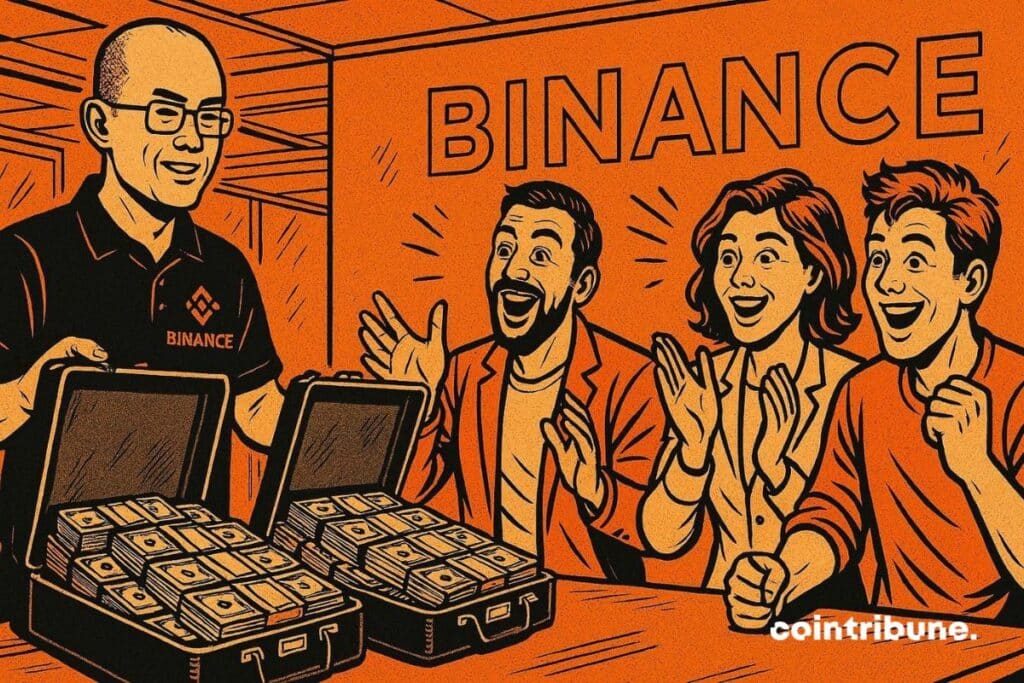Binance announces additional $400 million for traders affected by the crash
The crypto market underwent one of its worst crashes, leading to record liquidations. Facing the crisis, Binance, the world leader in exchanges, announces an additional $400 million fund to support traders. An unprecedented initiative, but will it be enough to restore investor confidence?

In brief
- Binance injects an additional $400 million (making a total of $683 million) to offset traders’ losses after the crypto crash.
- BNB, down 2%, could rebound if confidence returns, but its future will depend on the crypto market’s stability.
- This crisis has rekindled the debate on exchange accountability: Is Binance acting as a savior or trying to avoid harsher sanctions?
+$400 million: Binance to the rescue of crypto traders
After being pointed out as the source of chaos after the crypto crash, Binance first released $283 million on Monday to compensate losses. This initial wave targeted traders affected by price discrepancies on stable pairs like USDT and USDC. A quick response, but insufficient given the scale of liquidations.
The platform then announced an additional $400 million fund to cover losses related to the widespread crypto market collapse. For a total of nearly $700 million.
The eligibility criteria remain unclear, but the goal is clear: to restore trust. Some see it as a marketing strategy, others as an attempt to retain users in a context of increased competition. This dual intervention nevertheless raises questions. Is Binance acting out of altruism or necessity?
BNB, the big winner of the operation?
Currently, BNB is under downward pressure with a 2% drop, trading around $1184. This trend reflects the widespread distrust after the recent crypto crash and massive liquidations.
The additional $400 million offer by Binance could reverse this trend. Historically, Binance’s initiatives to stabilize its ecosystem have often resulted in significant rebounds for BNB. However, nothing is certain in the crypto ecosystem and several factors could limit this rise:
- Persistent trader distrust after record liquidations;
- The overall volatility of the crypto market, influenced by macroeconomic and political factors;
- Future regulations that could weigh on Binance and its crypto token.
However, if Binance manages to restore confidence and demonstrate the robustness of its ecosystem, BNB could aim for higher levels, such as $2,000 or $2,500 by the end of 2025.
Crypto crash: Is Binance playing the firefighter and arsonist?
The recent crash revealed the flaws in the crypto system. Massive liquidations were amplified by leverage, a tool heavily promoted by Binance and its competitors. Some accuse the platform of contributing to the crisis by encouraging risky trading. This is the case of Crypto.com CEO, Kris Marszalek, who demands that an investigation be opened against Binance.
Binance presents itself today as the solution, but its role in the genesis of the problem is controversial. This raises the issue of the responsibility of crypto exchanges. By compensating for losses, is Binance implicitly admitting its faults? Or is it a maneuver to avoid stricter regulations?
Binance makes history by unlocking an additional $400 million to support traders. This initiative could revive the BNB, but its long-term impact remains uncertain. One thing is sure: this crisis questions the future of crypto regulation and exchange responsibility. And you, do you think Binance acted out of altruism or interest?
Maximize your Cointribune experience with our "Read to Earn" program! For every article you read, earn points and access exclusive rewards. Sign up now and start earning benefits.
The world is evolving and adaptation is the best weapon to survive in this undulating universe. Originally a crypto community manager, I am interested in anything that is directly or indirectly related to blockchain and its derivatives. To share my experience and promote a field that I am passionate about, nothing is better than writing informative and relaxed articles.
The views, thoughts, and opinions expressed in this article belong solely to the author, and should not be taken as investment advice. Do your own research before taking any investment decisions.